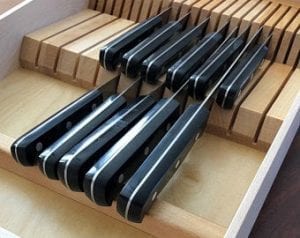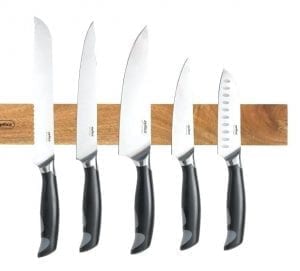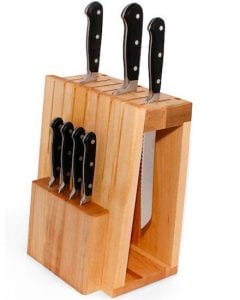Esssential Tips for Storing Knives
When we are aware of the possible hazards, it is easier to minimize any danger. This is especially true about kids and knives in our homes.
 The kitchen is a compelling place for kids, with parents bustling around, making meals, pulling colorful items from the refrigerator. Cooking and baking can be a very enjoyable time for the family. Knives play a big part of kitchen activities. With everything going on, your divided attention, and kids’ excitement, it’s important to make sure you have good knife habits, but also to store knives properly.
The kitchen is a compelling place for kids, with parents bustling around, making meals, pulling colorful items from the refrigerator. Cooking and baking can be a very enjoyable time for the family. Knives play a big part of kitchen activities. With everything going on, your divided attention, and kids’ excitement, it’s important to make sure you have good knife habits, but also to store knives properly.
Reduce the risks of accidents and problems with these tips:
- The most important tip – Never keep your knife close to the edge of counters or appliances where little hands can reach them. It is important to remind yourself and others in the kitchen of this every day.
- Never keep your knives in a wet sink, especially overnight. Wet, slippery sinks are where rust can easily form, damaging the blade of the knife. It’s always best to wash your kitchen knives (and dry them) as soon as you’re done using them. Or, at least, wash your knives first when doing the dishes. This is not just good for the blades, but also keeps kids from accidentally hurting themselves putting hands in a murky or bubbly sink of water.
- Never let your knives roam free in a drawer. There’s a possibility that, if the knives are left free in the drawer, the kids, or you, may end up getting cut. Not only that, but, rattling around in a drawer will damage the blades.
To store your knife properly, here are a few solutions:
- Drawer Storage – Drawer storage is a good method for knife storage. For the greatest versatility and keeping knives protected, get
 drawer inserts made for knives. This way, each blade gets its own home, and the blades of the knives are protected from jostling with other utensils. There are a variety of drawer inserts on the market, but it’s best to pick one with slots that can fit a range of knife sizes. Consider storing your knives in a drawer with a safety latch that is not easily unlocked by unsupervised kids.
drawer inserts made for knives. This way, each blade gets its own home, and the blades of the knives are protected from jostling with other utensils. There are a variety of drawer inserts on the market, but it’s best to pick one with slots that can fit a range of knife sizes. Consider storing your knives in a drawer with a safety latch that is not easily unlocked by unsupervised kids. - Magnetic Wall Storage – If you have the available space, magnetic wall strips above your countertop are a safey way to store your kitchen knives. It saves counter space and
 looks stylish too. Plus, you will be able to easily access each blade and yet keep them all away from the kids. This storage method means you won’t have to remember which knife goes in which slot. No more pulling every knife out of the drawer until you find the one you want. Magnetic wall strips come in various metal and wood finishes so you can get one that complements your kitchen decor. Choose a wall strip that is strong enough to hold the knives but not so strong that they snatch the blade as it gets close. If it is too strong, it can damage the blade by slapping it against the magnetic bar. You will need a little bit of technique to avoid potential damage to the sharp edge from a hard slap.
looks stylish too. Plus, you will be able to easily access each blade and yet keep them all away from the kids. This storage method means you won’t have to remember which knife goes in which slot. No more pulling every knife out of the drawer until you find the one you want. Magnetic wall strips come in various metal and wood finishes so you can get one that complements your kitchen decor. Choose a wall strip that is strong enough to hold the knives but not so strong that they snatch the blade as it gets close. If it is too strong, it can damage the blade by slapping it against the magnetic bar. You will need a little bit of technique to avoid potential damage to the sharp edge from a hard slap.
- Wall Mounted Knife Block – Another knife storage method to consider is a wall mounted knife block. This is probably the most
 popular method of knife storage, especially because most knife sets are sold in their own blocks that vcan be mounted easily on the kitchen wall. However, if you have a collection of mixed knives, blocks that came with your cutlery set can be very limiting and frustrating. Check out a universal shotless knife block. These blocks are filled with plastic and rubber rods in teh center to flex and are versatile to meet your needs.
popular method of knife storage, especially because most knife sets are sold in their own blocks that vcan be mounted easily on the kitchen wall. However, if you have a collection of mixed knives, blocks that came with your cutlery set can be very limiting and frustrating. Check out a universal shotless knife block. These blocks are filled with plastic and rubber rods in teh center to flex and are versatile to meet your needs.
In the kitchen, there are a lot of utensils and apopliances that can cause injuries to kids if not stored and used properlyl. Knives are definitely at the top of the list. It is essential that you make sure your kitchen knives are stored prioeprty so that kids do not accidentaly hurt themselves, and also to keep your knives in good shape.
Do you have any other tips to share?
Bill Perkins, Guest Contributor
Perkins Knives
P.S. We strongly recommend that you do NOT store your camping knives in your kitchen with your kitchen knives. Keep them with the rest of your camping supplies in one place, but out of reach of children.


